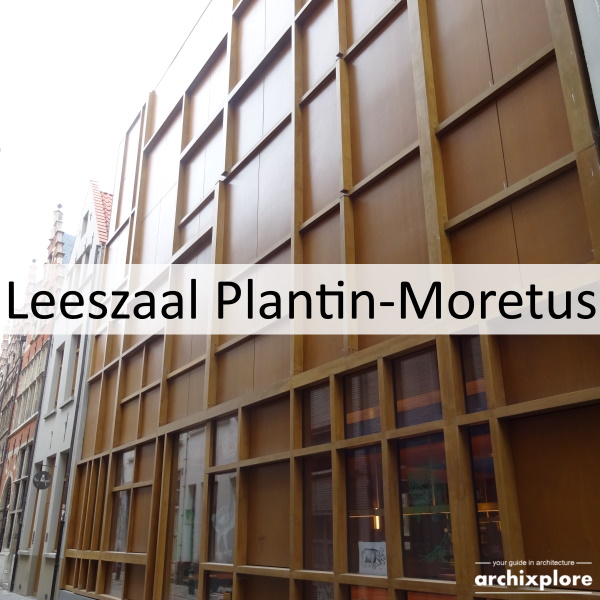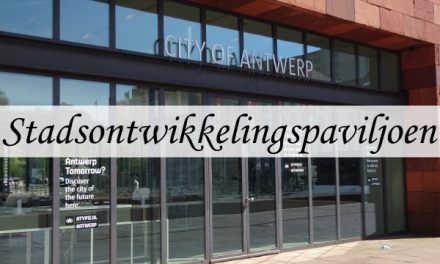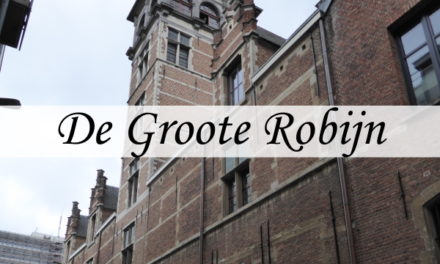
Reading Room and Depot Museum Plantin-Moretus
noAarchitecten
Antwerp, Heilige Geeststraat 6
2009 – 2016
Museum Plantin-Moretus
As you well know, I have a soft spot for the Plantin-Moretus Museum. I have been able to guide people around here for several years and I still do that with great pleasure. The building complex is typically Belgian, a renovation here, an extension there and therefore also nice for me as an architect. You have different styles, even contemporary architecture like the new building in the Heilige Geeststraat. This part is featured in this article. So I am only discussing a small part of the museum.
NoAarchitecten
NoAarchitecten consists of An Fonteyne, Jitse van den Berg and Philippe Viérin. It was rather by chance established in 2000 to participate in a competition. The team of 25 people is spread over two locations: in Brussels and Bruges. From September 2004 to January 2005 there was an exhibition about the office in deSingel in Antwerp, you can find a video about this at the bottom of the article (in Dutch).
Benoit Van Innis
Artist and designer Benoit Van Innis (° 1960) has collaborated several times with architectural firms. In collaboration with Marie-José Van Hee and Robbrecht en Daem architects, he designed areas of color for the Markt in Deinze. He collaborated with noAarchitecten on the Bistro De Refter in Bruges and the Menen town hall. Van Innis forms a dialogue with his environment. Here too, at the Plantin – Moretus Museum, he makes a connection with the printing office. Van Innis designed the wooden facade with a reference to the type cases used by the typesetters, which you can see in the museum.
Nice detail: Benoit Van Innis shares a studio with noAarchitecten in a former printing works in Anderlecht, Brussels.
Reading room
The reading room of the museum used to be ‘hidden’ somewhere in the building. Now it is visible in the city. The large windows allow you to peek inside the reading room with its leather walls and blue ceiling. The leather is a reminder of the gold leather that you also see in the museum, but it is good for acoustics. There are long tables, which is sometimes necessary to view major works, such as maps. At the back a manual library with a glass roof above it. There are automatic blinds that protect these books from direct sunlight.
The used materials and colors match the character that you also find in the museum.
Depot
Above the reading room there are three depot areas. You can also notice this on the facade, because above the windows of the ground floor, there’s a blind facade. In addition to the paper collections (old prints, archival documents, manuscripts, drawings and prints), the depot also contains paintings. The latter are packed (see photo below) and are hang on the walls. There is a double-height depot where mainly paper is stored, the automatic compact cabinets are impressive here. To organize an archive as optimally as possible, cabinets are used that are all set up against each other with only space for one or two corridors in between. Manually or automatically, the cabinets can be separated to access the objects in the cabinets. You can also see this when you take a behind-the-scenes tour of the Hendrik Conscience Heritage Library.
Protection
It is important to protect the works in the depot. The climate is optimised for the storage of paper, i.e. a constant temperature of 20° and a relative humidity of 50%. This for the whole of 2.22 kilometers of shelves! Also interesting is the fire protection, here with an extinguishing gas. The expensive extinguishing gas is stored in liquid form in the basement of the building and is converted into gas in the event of a fire. It will suppress the heat and there is a chemical reaction with the flames to extinguish them.
Reading Room and depot Museum Plantin-Moretus
This article first appeared on my other site about architecture in and around Antwerp: archiplore.

More architecture in Antwerp
The Silversmith Building and Silversmith Alley
Silversmith Building Antwerp architect unknown Antwerp, Lange Koepoortstraat 58 1561-1570 Silversmith Building Antwerp Last week I visited the Silversmith Building and the accompanying Silversmith Alley for the first time. I was expected in the Lange Koepoortstraat in...
Maagdenhuis – museum in a former orphanage
Maagdenhuis Lange Gasthuisstraat 33, AntwerpLange Gasthuisstraat The Maagdenhuis is a museum that is not really known in Antwerp. It is located on the Mechelseplein, in the Lange Gasthuisstraat. It is a good neighbourhood, with the other smaller museum, Mayer Van den...
The Stock Exchange of Antwerp by architect Schadde
Stocj Exchange Antwerp Joseph Schadde Antwerp, Twaalfmaandenstraat 1872 Stock Exchange Antwerp After years of waiting, the time has finally come: the Antwerp Stock Exchange can be visited freely. This summer there is a pop-up terrace in the covered courtyard and an...

















